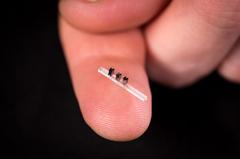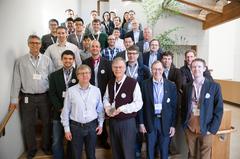URL: https://www.desy.de/news/news_search/index_eng.html
Breadcrumb Navigation
DESY News: Particle accelerator on a microchip
News
News from the DESY research centre
Particle accelerator on a microchip
The Gordon and Betty Moore Foundation has awarded 13.5 million US dollars (12.6 million euros) to promote the development of a particle accelerator on a microchip. DESY and the University of Hamburg are among the partners involved in this international project, headed by Robert Byer of Stanford University (USA) and Peter Hommelhoff of the University of Erlangen-Nürnberg. Within five years, they hope to produce a working prototype of an “accelerator-on-a-chip”.

Three “accelerators on a chip” made of silicon are mounted on a clear base. Credit: SLAC National Accelerator Laboratory
“The impact of shrinking accelerators can be compared to the evolution of computers that once occupied entire rooms and can now be worn around your wrist,” says Hommelhoff. This advance could mean that particle accelerators will become available in areas that have previously had no access to such technologies.
The aim of the project is to develop a new type of small, inexpensive particle accelerator for a wide range of different users. Apart from using the fast electrons themselves, they could also be used to produce high-intensity X-rays. “This prototype could set the stage for a new generation of ‘tabletop’ accelerators, with unanticipated discoveries in biology and materials science and potential applications in security scanning, medical therapy and X-ray imaging,” explains Byer.

Some of the accelerator-on-a-chip designs being explored by the international collaboration. Credit: SLAC National Accelerator Laboratory
“The typical transverse dimensions of an accelerator cell shrink from ten centimetres to one micrometre,” adds Ingmar Hartl, head of the laser group in DESY’s Photon Science Division. At the moment, the material of choice for the miniature accelerator modules is silicon. “The advantage is that we can draw on the highly advanced production technologies that are already available for silicon microchips,” explains Hartl.
DESY will bring its vast knowhow as an internationally leader in laser technology to the project, which has already paid off in other collaborations involving the University of Erlangen-Nürnberg. There, Hommelhoff’s group showed that for slow electrons a micro-structured accelerator module is able to achieve steeper acceleration gradients than RF technology. Byer’s group had demonstrated independently the same effect for fast, so-called relativistic electrons.
However, it is still a long way from an experimental set-up in a laboratory to a working prototype. Individual components of the system will have to be developed from scratch. Among other things, DESY is working on a high-precision electron source to feed the elementary particles into the accelerator modules, a powerful laser for accelerating them, and an electron undulator for creating X-rays. In addition, the interaction between the miniature components is not yet a routine matter, especially not when it comes to joining up several accelerator modules.

Members of the international scientific collaboration to build a working prototype of a particle accelerator based on “accelerator on a chip” technology gathered at the Moore Foundation in October for a kick-off meeting to discuss the endeavor. Credit: SLAC National Accelerator Laboratory
Apart from DESY, the Universities of Stanford, Erlangen-Nürnberg and Hamburg, SLAC National Accelerator Laboratory in the US, the Swiss Paul Scherrer Institute (PSI) and the University of California in Los Angeles (UCLA), the Purdue University, the Swiss Federal Institute of Technology in Lausanne (EPFL) and the Technical University of Darmstadt are also involved in the project, as well as the US company Tech-X.
The Gordon and Betty Moore Foundation fosters path-breaking scientific discovery, environmental conservation, patient care improvements and the preservation of the special character of the San Francisco Bay Area. Gordon Moore is one of the founders of the chip manufacturer Intel and the author of “Moore's Law”, which predicts that the number of transistors in an integrated circuit doubles approximately every two years.
Further information: Press release of the Gordon and Betty Moore Foundation; release and video from SLAC National Accelerator Laboratory



